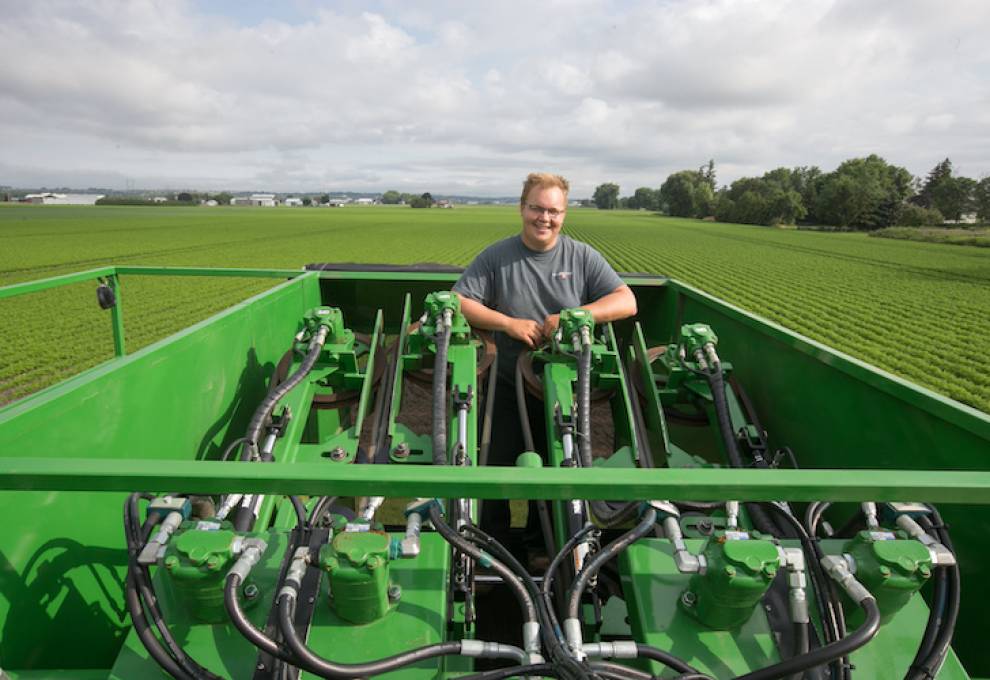

Big iron is common to muck crop growers. What’s new is that self-propelled harvesters are now designed to gather up two rows of carrots, doubling the usual one row. Rather than harvest 20 to 25 tons per hour, the machine can harvest 40 to 45 tons per hour.
More than that, these lumbering machines are equipped with a bristle belt made of thousands of rubber fingers that scrub dirt off the carrots before they tumble onto a conveyor belt. That’s why Doug Van Luyk has invested in a Vogel Engineering Extreme Cleaning Carrot Harvester. The ability to keep soil in the field has become an important consideration when selling to nearby packers. In the value chain, they are responsible for cleaning carrots for ultimate sale – a costly process that requires de-dirting equipment and water cleaning.
“I’ve been making carrot harvesters for 37 years,” says Wayne Vogel, Holton, Michigan. “The unique aspect of this machine is that the carrots fall from the topping bar and spend a few seconds on the bristle belt while fans blow air over them.”
All vegetable growers in the Holland Marsh and other muck-growing areas became more sensitized to issues of soil and water when provincial environmental regulations tightened around water discharge from cleaning facilities. A 2016 engineering report called “Soil Removal and Turbidity Monitoring for Carrot Washing” was one such wake-up call. Going forward, what growers had to factor into their operations is that delivering cleaner carrots to their customers was table stakes for staying in the game.
“There’s a demand for quality carrots,” says Van Luyk. “With this harvester, we’ve been able to expand our carrot acreage by 30 per cent in the last two years to 350 acres. We’re also growing more carrots on mineral soils in a three-year rotation.”
Vegetable growers on mineral soils are also investing in equipment. Exeter Produce located in southwestern Ontario is one example, farming more than 4,000 acres of beans, cabbage, rutabaga, field peppers and rotational crops of corn, soybeans and wheat.
This is the second season for employing a two-robot, four-row Ferrari Futura transplanter for cabbage says crop specialist John Beardsley. The robots pick the plugs out of the trays.
“There were a lot of challenges the first year,” says Beardsley. “It was a learning curve for our propagator because the plants have to be as upright as possible. We want no intermingling of the leaves between plugs. Because we were behind in getting to the field, the plants grew larger in the greenhouse than we wanted.”
Those challenges have been met and the 2019 planting has been smoother with 200 acres of cabbage. Rather than 14 to 16 seasonal workers engaged in transplanting, the new machine requires only three workers. The pace allows for seven acres of cabbage to be planted in a day. Given the wet spring, another advantage is the ability to plant quickly during brief weather windows of opportunity.
The next investment in labour-saving equipment has been a Remoweed. Instead of hand hoeing weeds out of cabbage fields, this machine allows for mechanical weed control.
“We had to made adjustments on the fly,” says Beardsley. “The European equipment is calibrated in metric so we had to convert from inches to centimetres. Once we trained our workers how to make those changes, life was good.”
Both of these pieces of equipment were sourced from Albert van Oosten, Specialty Vegetable Equipment, Princeton, Ontario. He’s responsible for being in the field and making sure that equipment sales live up to their potential.
“We deal with start-up issues and nervous farmers, but this is the future, no matter what,” says van Oosten.
What’s the next big thing? Fumigants are being legislated out of use, so watch for equipment that steams soils for weed control.
Karen Davidson, editor of The Grower, goes behind the scenes of this story to talk with John Beardsley. He’s the crop specialist for Exeter Produce, Exeter, Ontario. Click here to listen.

Add new comment